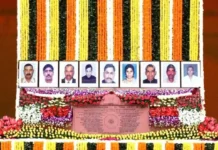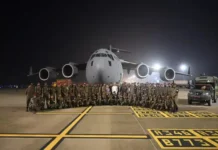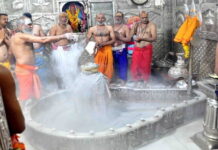AHMEDABAD: Over 17 years after the post- Godhra riots, the Nanavati Commission has given a clean chit to the then chief minister Narendra Modi’s government for the violence that killed 1,000 people in Gujarat, but said local VHP and Bajrang Dal workers were involved in incidents in their areas.
The two-member enquiry commission’s report, which runs into more than 2,500 pages, was tabled in the Gujarat Assembly on Wednesday. The report rejected the evidence provided by three former IPS officers, who had taken on the then government, but said police personnel were ill-equipped and their strength was inadequate to deal with the situation, which emboldened mobs to commit violence.
The inquiry commission was headed by Justice G T Nanavati, a retired Supreme Court judge, and Justice Akshay Mehta, an ex-Gujarat High Court judge, was its other member. The Nanavati-Mehta panel noted that “There is no evidence to show these attacks were either inspired or instigated or abetted by any minister of the state. The commission was appointed by the then chief minister Narendra Modi to probe the riots which took place after the burning of two coaches of Sabarmati Express train near Godhra railway station, in which 59 ‘karsevaks’ were killed on February 27, 2002.
“On an overall consideration of the entire material, the commission finds that the communal riots which followed the Godhra incident (the train fire) were really by way of aftermath of that incident,” said the panel in its report which has nine volumes. “It was because of the Godhra incident that large sections of Hindu community became very angry and ultimately indulged in violent attacks on Muslims and their properties,” the report observed.
The commission said it did not find any evidence against “any religious or political party or organisations as such” in connection with the riots. “The only thing that can be said with some certainty, on the basis of evidence which has come before the commission, is that local members of the VHP and Bajrang Dal took part in the incidents which happened in their localities,” it said.
The panel said the post-Godhra riots that spread out in the state were “not a pre-planned conspiracy or orchestrated violence”.
There is no substance in allegations that state authorities had turned a blind eye to the post-Godhra riots, it said. The commission sought to dispel suspicion on Modis visit to Godhra, around 125km from here, on the day of the train burning (February 27, 2002). It was not necessary for the chief minister to inform all high officers of the state that he was going to Godhra.
The concerned officers were informed about his visit and they had made necessary arrangements for that visit. “It was not a secret visit… There is also no material to show that the chief minister, by entering the burnt coach-S6, disturbed any evidence and that it was done with some ulterior motive, the report said.
The panel questioned the credibility of three former IPS officers — Sanjiv Bhatt, Rahul Sharma and R B Sreekumar — who had alleged the state government’s involvement in the riots.
After close scrutiny of the evidence, it is not possible to say that there was any negligence on the part of police, it noted. However, it is very much necessary the state has a disciplined police force to ensure that peace and tranquillity of the society is not disturbed, the panel said.
“While considering the evidence relating to the incidents which happened during the communal riots, we have noticed that the absence of police or their inadequate number emboldened the mobs to indulge in violence,” it said. On allegations police officers allowed miscreants to attack Muslims in Ahmedabad city during the riots, the panel said things went out of control because police were outnumbered and ill-equipped to rein in violent mobs whose strength went up to more than 10,000 people at some places.
On riots in Ahmedabad city, one of the worst affected areas in the state, the commission said, “The police had not shown their competence and eagerness which was necessary.” The report has recommended inquiries or action, which were halted after the commission was formed, against the erring police officers.
It said the authorities should see the media acts with “restraint” during such difficult times (riots), and that immediate effective action should be taken against the media if it is found to be transgressing the limits. The media should ensure it does not become instrumental in provoking more communal violence by publishing “exaggerated” reports about incidents, the panel said.
Ensuring an adequate number of well-equipped policemen, educating the masses about true religion and highlighting the harm caused by communal riots, are some of the recommendations made by the panel to control such violent situations in the future.
In another suggestion, the panel said it should be ensured the media shows restraint while reporting such incidents. The first part of the commission’s report was tabled in the Assembly on September 25, 2009.
The panel submitted its final report (part two) on November 18, 2014, to the then chief minister Anandiben Patel, but its findings were not made public then. In September this year, the BJP government told the Gujarat High Court that it will table the report in the next Assembly session. The government made the submission while responding to a PIL filed by former IPS officer R B Sreekumar, seeking a direction to the state to make the report public.
Sreekumar, an ex-DGP who had filed affidavits before the Nanavati Commission and questioned the state government’s “inaction” during the riots, made a representation to the then chief minister Patel in November 2015, demanding the entire report be made public.
In February 2002, the then chief minister Modi had announced setting up of a one-member commission to inquire into the cause of the Godhra train burning and the subsequent communal violence in Gujarat in which more than 1,000 people, most of them from a minority community, where killed.
The government later reconstituted the commission, with Justice Nanavati as its chairman and Justice K G Shah, a former Gujarat High Court judge, as a member. After Justice Shah died, Justice Mehta took his place.
The government also expanded the terms of reference of the commission, bringing under its purview the role and conduct of the then chief minister, ministers and police officers during the riots. PTI







